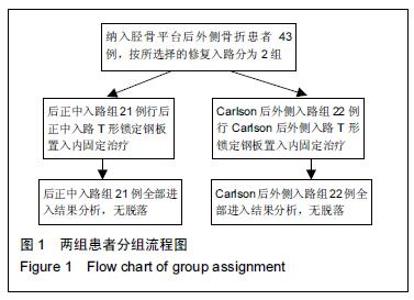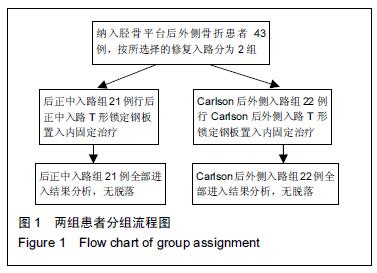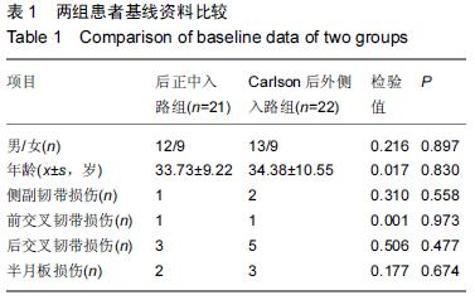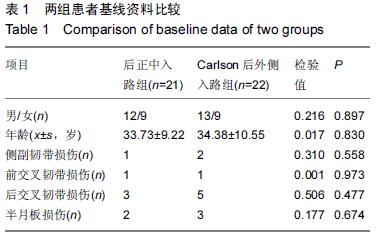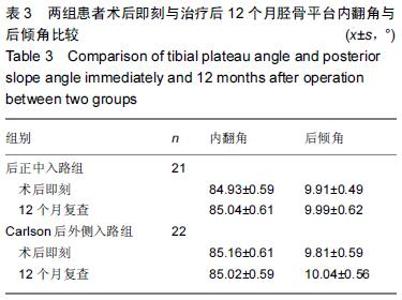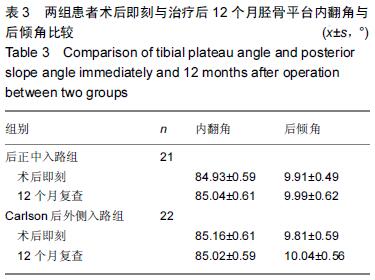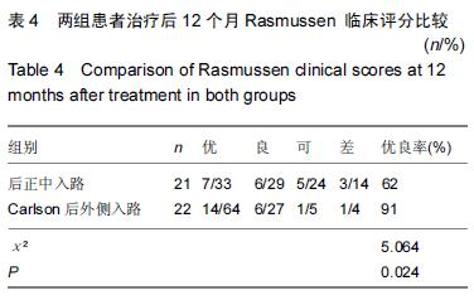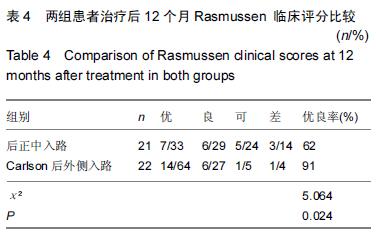Chinese Journal of Tissue Engineering Research ›› 2016, Vol. 20 ›› Issue (17): 2511-2518.doi: 10.3969/j.issn.2095-4344.2016.17.011
Previous Articles Next Articles
“T”-shaped locking plate for posterolateral tibial plateau fractures by Carlson posterolateral approach: 12-month follow-up
Feng Chong1, Jia Dai-liang2, Lei Xue-feng2, Zhang Gang3, Xing Qi-ning3
- 12013 Postgraduate Student, Jining Medical University, Jining 272011, Shandong Province, China; 2First Clinical College of Jining Medical University, Jining 272011, Shandong Province, China; 3Affiliated Hospital of Jining Medical University, Jining 272011, Shandong Province, China
-
Received:2016-03-13Online:2016-04-22Published:2016-04-22 -
Contact:Lei Xue-feng, Professor, Chief physician, First Clinical College of Jining Medical University, Jining 272011, Shandong Province, China -
About author:Feng Chong, Studying for master’s degree, 2013 Postgraduate Student, Jining Medical University, Jining 272011, Shandong Province, China -
Supported by:the Shandong Provincial Natural Science Foundation, China, No. ZR2015HL027
Cite this article
Feng Chong, Jia Dai-liang, Lei Xue-feng, Zhang Gang, Xing Qi-ning. “T”-shaped locking plate for posterolateral tibial plateau fractures by Carlson posterolateral approach: 12-month follow-up[J]. Chinese Journal of Tissue Engineering Research, 2016, 20(17): 2511-2518.
share this article
| [1] Solomon LB, Stevenson AW, Lee YC, et al. Posterolateral and anterolateral approaches to unicondylar posterolateral tibial plateau fractures: a comparative study. Injury. 2013;44(11): 1561-1568. [2] Johnson EE, Timon S, Osuji C. Surgical technique: Tscherne-Johnson extensile approach for tibial plateau fractures. Clin Orthop Relat Res. 2013;471(9): 2760-2767. [3] Xiang G, Zhi-Jun P, Qiang Z, et al. Morphological characteristics of posterolateral articular fragments in tibial plateau fractures. Orthopedics. 2013;36(10): e1256-e1261. [4] 袁耀,周云斌,任良,等.塌陷型胫骨平台骨折手术治疗的临床研究[J].浙江创伤外科,2009,14(3):263-264. [5] Cross WW, Levy BA, Morgan JA, et al. Periarticular raft constructs and fracture stability in split-depression tibial plateau fractures. Injury. 2013;44(6):796-801. [6] 张成亮,陈德权,谭诗平,等.后侧入路钢板内固定治疗胫骨平台后侧劈裂骨折[J].中国骨与关节损伤杂志,2011, 26(2):155-156. [7] Xiang G, Zhi JP, Qiang Z, et al. Morphological characteristics of posterolateral articular fragments in tibial plateau fractures. Orthopedics. 2013;36(10): e1256-e1261. [8] Partenheimer A, Gösling T, Müller M, et al. Management of bicondylar fractures of the tibial plateau with unilateral fixed-angle plate fixation. Der Unfallchirurg. 2007;110(8): 675-683. [9] 曾炳芳,罗从风.重视胫骨近端骨折的治疗[J].中华创伤骨科杂志, 2004,6(3):241-243. [10] Kandemir U, Maclean J. Surgical approaches for tibial plateau fractures. J Knee Surg. 2014;27(1): 21-29. [11] 陈星佐,林朋,刘成刚,等.关节镜辅助复位内固定治疗胫骨平台骨折的研究进展[J].中华创伤骨科杂志,2014,16(7): 622-624. [12] 李成,周其佳,王友华,等.后外或后内入路手术治疗胫骨平台后柱骨折[J].实用骨科杂志,2010,16(3):224-226. [13] Chan YS, Yuan LJ, Hung SS, et al. Arthroscopic- assisted reduction with bilateral buttress plate fixation of complex tibial plateau fractures. Arthroscopy. 2003; 19(9): 974-984. [14] Hsieh CH. Treatment of the posterolateral tibial plateau fractures using the anterior surgical approach. Int J Biomed Sci. 2010;6: 316-320. [15] Wang SQ, Gao YS, Wang JQ, et al. Surgical approach for high-energy posterior tibial plateau fractures. Indian J Orthop. 2011;45(2): 125. [16] 伍凯,黄建华,林健,等.超近端胫骨平台双髁骨折的临床特点及治疗策略[J].中华骨科杂志,2014,34(4):44l-447. [17] Canale ST, Beaty JH. Campbell's operative orthopaedics. Elsevier Health Sciences, 2012. [18] Ebraheim NA, Sabry FF, Haman SP. Open reduction and internal fixation of 117 tibial plateau fractures. Orthopedics. 2004;27(12): 1281-1287. [19] Kandemir U, Maclean J. Surgical approaches for tibial plateau fractures. J Knee Surg. 2014;27(1): 21-29. [20] Muhm M, Schneider P, Ruffing T, et al. Posterocentral approach to the posterior tibial plateau. Reconstruction of tibial plateau fractures and avulsions of the posterior cruciate ligament. Der Unfallchirurg. 2014;117(9): 813-821. [21] 张国柱,蒋协远,王满宜.CT 扫描对胫骨平台骨折分型及治疗的影响[J].中华创伤骨科杂志,2006,8(4):326-329. [22] Barei DP, O'Mara TJ, Taitsman LA, et al. Frequency and fracture morphology of the posteromedial fragment in bicondylar tibial plateau fracture patterns. J Orthop Trauma. 2008;22(3): 176-182. [23] Sohn HS, Yoon YC, Cho JW, et al. Incidence and fracture morphology of posterolateral fragments in lateral and bicondylar tibial plateau fractures. J Orthop Trauma. 2015;29(2): 91-97. [24] Waldrop JI, Macey TI, Trettin JC, et al. Fractures of the posterolateral tibial plateau. Am J Sports Med, 1988; 16(5): 492-498. [25] Watanabe K, Lenke LG, Bridwell KH, et al. Proximal junctional vertebral fracture in adults after spinal deformity surgery using pedicle screw constructs: analysis of morphological features. Spine. 2010;35(2): 138-145. [26] Lin KC, Tarng YW, Lin GY, et al. Prone and direct posterior approach for management of posterior column tibial plateau fractures. Orthop Traumatol Surg Res. 2015;101(4): 477-482. [27] Lustig S, Khiami F, Boyer P, et al. Post-traumatic knee osteoarthritis treated by osteotomy only. Orthop Traumatol Surg Res. 2010;96(8): 856-860. [28] Egol KA. Split depression posterolateral tibial plateau fracture: direct open reduction and internal fixation. Tech Knee Surg. 2005;4(4): 257-263. [29] He X, Ye P, Hu Y, et al. A posterior inverted L-shaped approach for the treatment of posterior bicondylar tibial plateau fractures. Arch Orthop Trauma Surg. 2013; 133(1): 23-28. [30] Tao J, Hang D, Wang Q, et al. The posterolateral shearing tibial plateau fracture: Treatment and results via a modified posterolateral approach. Knee. 2008; 15(6): 473-479. [31] 张金利,天祥,马宝通,等.后侧入路内固定治疗胫骨平台后侧骨折[J].中华骨科杂志,2011, 31(4):326-330. [32] 冯刚,潘志军,李杭,等.双锁定钢板交叉支撑固定治疗累及后外侧的C3型胫骨平台骨折[J].中华骨科杂志, 2014, 34(7): 695-702. [33] Borrelli Jr J. Management of soft tissue injuries associated with tibial plateau fractures. J Knee Surg. 2014;27(1): 5-9. [34] 范鑫斌,张岩,杨铁毅,等.胫骨平台后外侧骨折3种内固定方式的有限元分析[J]. 中国组织工程研究, 2014, 18(22): 3510-3516. [35] 王大平,熊建义,朱伟民,等.纳米羟基磷灰石人工骨修复塌陷型胫骨平台骨折[J].中国组织工程研究,2013,17(51): 8863-8868. [36] 夏江,俞光荣,周家钤,等.经后外侧入路治疗胫骨平台后外侧骨折的解剖学研究及应用[J].中国临床解剖学杂志, 2010,28(4):369-374. [37] 李瑞,王青山.生物材料生物相容性的评价方法和发展趋势[J].中国组织工程研究与临床康复,2011,15(29): 5471-5474. [38] 张金利,袁天祥,马宝通,等. 后侧入路内固定治疗胫骨平台后侧骨折[J].中华骨科杂志, 2011,31(4):326-330. [39] 孙辉,罗从风,曾炳芳.胫骨平台后侧骨折新型手术径路解剖学研究[J].中华创伤骨科杂志,2008,10(8):765-769. [40] Lin KC, Tarng YW, Lin GY, et al. Prone and direct posterior approach for management of posterior column tibial plateau fractures. Orthop Traumatol Surg Res. 2015;101(4): 477-482. |
| [1] | Zhang Tongtong, Wang Zhonghua, Wen Jie, Song Yuxin, Liu Lin. Application of three-dimensional printing model in surgical resection and reconstruction of cervical tumor [J]. Chinese Journal of Tissue Engineering Research, 2021, 25(9): 1335-1339. |
| [2] | Zeng Yanhua, Hao Yanlei. In vitro culture and purification of Schwann cells: a systematic review [J]. Chinese Journal of Tissue Engineering Research, 2021, 25(7): 1135-1141. |
| [3] | Xu Dongzi, Zhang Ting, Ouyang Zhaolian. The global competitive situation of cardiac tissue engineering based on patent analysis [J]. Chinese Journal of Tissue Engineering Research, 2021, 25(5): 807-812. |
| [4] | Wu Zijian, Hu Zhaoduan, Xie Youqiong, Wang Feng, Li Jia, Li Bocun, Cai Guowei, Peng Rui. Three-dimensional printing technology and bone tissue engineering research: literature metrology and visual analysis of research hotspots [J]. Chinese Journal of Tissue Engineering Research, 2021, 25(4): 564-569. |
| [5] | Chang Wenliao, Zhao Jie, Sun Xiaoliang, Wang Kun, Wu Guofeng, Zhou Jian, Li Shuxiang, Sun Han. Material selection, theoretical design and biomimetic function of artificial periosteum [J]. Chinese Journal of Tissue Engineering Research, 2021, 25(4): 600-606. |
| [6] | Liu Fei, Cui Yutao, Liu He. Advantages and problems of local antibiotic delivery system in the treatment of osteomyelitis [J]. Chinese Journal of Tissue Engineering Research, 2021, 25(4): 614-620. |
| [7] | Li Xiaozhuang, Duan Hao, Wang Weizhou, Tang Zhihong, Wang Yanghao, He Fei. Application of bone tissue engineering materials in the treatment of bone defect diseases in vivo [J]. Chinese Journal of Tissue Engineering Research, 2021, 25(4): 626-631. |
| [8] | Zhang Zhenkun, Li Zhe, Li Ya, Wang Yingying, Wang Yaping, Zhou Xinkui, Ma Shanshan, Guan Fangxia. Application of alginate based hydrogels/dressings in wound healing: sustained, dynamic and sequential release [J]. Chinese Journal of Tissue Engineering Research, 2021, 25(4): 638-643. |
| [9] | Chen Jiana, Qiu Yanling, Nie Minhai, Liu Xuqian. Tissue engineering scaffolds in repairing oral and maxillofacial soft tissue defects [J]. Chinese Journal of Tissue Engineering Research, 2021, 25(4): 644-650. |
| [10] | Xing Hao, Zhang Yonghong, Wang Dong. Advantages and disadvantages of repairing large-segment bone defect [J]. Chinese Journal of Tissue Engineering Research, 2021, 25(3): 426-430. |
| [11] | Chen Siqi, Xian Debin, Xu Rongsheng, Qin Zhongjie, Zhang Lei, Xia Delin. Effects of bone marrow mesenchymal stem cells and human umbilical vein endothelial cells combined with hydroxyapatite-tricalcium phosphate scaffolds on early angiogenesis in skull defect repair in rats [J]. Chinese Journal of Tissue Engineering Research, 2021, 25(22): 3458-3465. |
| [12] | Wang Hao, Chen Mingxue, Li Junkang, Luo Xujiang, Peng Liqing, Li Huo, Huang Bo, Tian Guangzhao, Liu Shuyun, Sui Xiang, Huang Jingxiang, Guo Quanyi, Lu Xiaobo. Decellularized porcine skin matrix for tissue-engineered meniscus scaffold [J]. Chinese Journal of Tissue Engineering Research, 2021, 25(22): 3473-3478. |
| [13] | Mo Jianling, He Shaoru, Feng Bowen, Jian Minqiao, Zhang Xiaohui, Liu Caisheng, Liang Yijing, Liu Yumei, Chen Liang, Zhou Haiyu, Liu Yanhui. Forming prevascularized cell sheets and the expression of angiogenesis-related factors [J]. Chinese Journal of Tissue Engineering Research, 2021, 25(22): 3479-3486. |
| [14] | Liu Chang, Li Datong, Liu Yuan, Kong Lingbo, Guo Rui, Yang Lixue, Hao Dingjun, He Baorong. Poor efficacy after vertebral augmentation surgery of acute symptomatic thoracolumbar osteoporotic compression fracture: relationship with bone cement, bone mineral density, and adjacent fractures [J]. Chinese Journal of Tissue Engineering Research, 2021, 25(22): 3510-3516. |
| [15] | Liu Liyong, Zhou Lei. Research and development status and development trend of hydrogel in tissue engineering based on patent information [J]. Chinese Journal of Tissue Engineering Research, 2021, 25(22): 3527-3533. |
| Viewed | ||||||
|
Full text |
|
|||||
|
Abstract |
|
|||||
